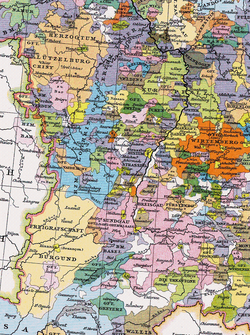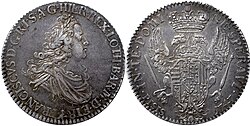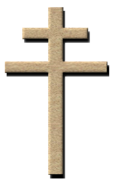Duchy of Lorraine
Duchy of Lorraine | |||||||||
|---|---|---|---|---|---|---|---|---|---|
| 959–1766 | |||||||||
Coat of arms
(1300–1766) | |||||||||
| Motto:Un pour tout ou Une pour toutes(French)[1] One for everything "or" One for all " | |||||||||
 Duchy of Lorraine (blue) within the Holy Roman Empire (c. 1400) | |||||||||
| Status | Part ofEast Francia(959–962) Stateof theHoly Roman Empire(962–1766) | ||||||||
| Capital | Nancy | ||||||||
| Religion | Roman Catholicism | ||||||||
| Demonym(s) | Lorrainian | ||||||||
| Government | Duchy | ||||||||
| Duke | |||||||||
• 959–978 | Frederick I of Bar | ||||||||
• 1737–1766 | Stanisław Leszczyński | ||||||||
| History | |||||||||
•Lotharingiadivided | 959 | ||||||||
• Joined Upper Rhenish Circle | 1500 | ||||||||
• French invasion and occupation of the Duchy of Lorraine | 1643 | ||||||||
• French invasion and subsequent occupation for 30 years | 1670 | ||||||||
• French invasion during War of the Spanish Succession | 1702 | ||||||||
• Annexed byFrance | 1766 | ||||||||
| |||||||||
| Today part of | |||||||||
| Part ofa serieson |
| Lorraine |
|---|
 |
TheDuchy of Lorraine(French:Lorraine[lɔʁɛn];‹See Tfd›German:Lothringen[ˈloːtʁɪŋən]), originallyUpper Lorraine,was aduchynow included in the larger present-day region ofLorrainein northeastern France. Its capital wasNancy.
It was founded in 959 following the division ofLotharingiainto two separate duchies: Upper andLower Lorraine,the westernmost parts of theHoly Roman Empire.The Lower duchy was quickly dismantled, while Upper Lorraine came to be known as simply the Duchy of Lorraine. The Duchy of Lorraine was coveted and briefly occupied by thedukes of Burgundyand thekings of France,but was ruled by the dukes of theHouse of Lorraineafter 1473.
In 1737, the duchy was given toStanisław Leszczyński,the former king ofPoland,who had lost his throne as a result of theWar of the Polish Succession,with the understanding that it would fall to the French crown on his death. When Stanisław died on 23 February 1766, Lorraine was annexed by France and reorganized as the province ofLorraine and Barrois.
History
[edit]
Lotharingia
[edit]Lorraine's predecessor,Lotharingia,was an independentCarolingiankingdom under the rule of KingLothair II(855–869). Its territory had originally been a part ofMiddle Francia,created in 843 by theTreaty of Verdun,when the Carolingian empire was divided between the three sons ofLouis the Pious.Middle Francia was allotted to EmperorLothair I,therefore calledLotharii Regnum.On his death in 855, it was further divided into three parts, of which his son Lothair II took the northern one. His realm then comprised a larger territory stretching from theCounty of Burgundyin the south to theNorth Sea.In French, this area became known asLorraine,while in German, it was eventually known asLothringen.In theAlemanniclanguage once spoken in Lorraine, the -ingen suffix signified a property;[citation needed]thus, in a figurative sense, "Lotharingen" can be translated as "Land belonging to Lothair", or more simplified *Lothair's realm*.
As Lothair II had without heirs, his territory was divided by the 870Treaty of MeerssenbetweenEastandWest Franciaand finally came under East Frankish rule as a whole by the 880Treaty of Ribemont.After the East Frankish Carolingians became extinct with the death ofLouis the Childin 911, Lotharingia once again attached itself to West Francia, but was conquered by theGermankingHenry the Fowlerin 925. Stuck in the conflict with his rivalHugh the Great,in 942 KingLouis IV of Francerenounced all claims to Lotharingia.
Duchy of Upper Lorraine
[edit]In 953, the German kingOtto Ihad appointed his brotherBruno the GreatDuke of Lotharingia. In 959, Bruno divided theduchyinto Upper andLower Lorraine;this division became permanent following his death in 965. The Upper Duchy was further "up" the river system, that is, it was inland and to the south. Upper Lorraine was first denominated as the Duchy of theMoselle,both in charters and narrative sources, and its duke was thedux Mosellanorum.The usage ofLotharingia SuperiorisandLorrainein official documents begins later, around the fifteenth century. The first duke and deputy of Bruno wasFrederick I of Bar,son-in-law of Bruno's sisterHedwig of Saxony.
Lower Lorraine disintegrated into several smaller territories and only the title of a "Duke of Lothier"remained, held byBrabant.After the duchy of the Moselle came into the possession ofRené of Anjou,the name "Duchy of Lorraine" was adopted again, only retrospectively called "Upper Lorraine". At that time, several territories had already split off, such as theCounty of Luxembourg,theElectorate of Trier,theCounty of Barand the "Three Bishoprics"ofVerdun,MetzandToul.
The border between theEmpireand theKingdom of Franceremained relatively stable throughout theMiddle Ages.In 1301, CountHenry III of Barhad to receive the western part of his lands (Barrois mouvant) as a fief by KingPhilip IV of France.In 1475, theBurgundiandukeCharles the Boldcampaigned for the Duchy of Lorraine, but was finally defeated and killed at the 1477Battle of Nancy.In the 1552Treaty of Chambord,a number of insurgentProtestantImperial princes aroundMaurice, Elector of Saxonyceded the Three Bishoprics to KingHenry II of Francein turn for his support.
Due to the weakening of Imperial authority during the 1618–1648Thirty Years' War,France was able to occupy the duchy in 1634 and retained it until 1661 whenCharles IVwas restored. In 1670, the French invaded again, forcing Charles into exile; his nephew and heirCharles V(1643–1690) spent his life in the service of the ImperialHouse of Habsburg.France returned the Duchy in the 1697Treaty of Ryswickending theNine Years' Warand Charles' sonLeopold(1679–1729), became duke and was known as 'Leopold the Good;' in the 1701–1714War of the Spanish Succession,parts of Lorraine, including the capital Nancy, were again occupied by France, but Leopold continued to reign at theChâteau de Lunéville.
In 1737, after theWar of the Polish Succession,an agreement between France, the Habsburgs and the Lorraine House of Vaudémont assigned the Duchy toStanisław Leszczyński,former king ofPoland.He was also father-in-law to KingLouis XVof France, and had recently lost out to acandidatebacked byRussiaandAustriain the War of the Polish Succession. The duke of Lorraine,Francis Stephen,betrothed to the Emperor's daughter ArchduchessMaria Theresa,was compensated with theGrand Duchy of Tuscany,where the lastMediciruler had recently died without issue. France also promised to support Maria Theresa as heir to the Habsburg possessions under thePragmatic Sanction of 1713.Leszczyński received Lorraine with the understanding that it would fall to the French crown on his death. Thetitleof Duke of Lorraine was given to Stanisław, but also retained by Francis Stephen, and it figures prominently in the titles of his successors (as a non-claimant family name), theHouse of Habsburg-Lorraine.When Stanisław died on 23 February 1766, Lorraine was annexed by France and reorganized as aprovinceby the French government.
-
Lotharingia divided, around 1000 AD
Alsace, ceded toSuebia(Swabia) in 925
Upper Lorraine after 928
Lower Lorraine after 977 -
Lorraine as it was 1618–1648
-
Map of the Duchy of Lorraine (1756), showing its somewhat dispersed communes by region of France and Germany, for the latter the English and German term for the region isSaarland.
-
Map of the Duchy of Lorraine (1756) within the modern region.
-
Cross of Lorraine,symbol of Lorraine since the 15th century
-
Coat of arms of the Duchy (1697)
-
Full coat of arms of the Duchy,Siebmachers Wappenbuch,1703[2]
Culture
[edit]Tworegional languagessurvive in the region.
Lorraine Franconian,known asfranciqueorplatt (lorrain)in French, is aWest Central Germandialect spoken by a minority in the northern part of the region. This is distinct from the neighbouringAlsatian language,although the two are often confused. Neither has any form of official recognition.
Lorrainis a Romance dialect spoken by a minority in the southern part of the region.
The duchy produced a number of important painters, includingClaude Lorrain,Georges de La TourandJean LeClerc.
Like most ofFrance's regional languages(such asBreton,Franco-Provençal,Occitan,Alsatian,Catalan,BasqueandFlemish), Lorrain and Lorraine Franconian were largely replaced by French with the advent of mandatory public schooling in the 19th and 20th centuries.
See also
[edit]References
[edit]- ^Augustin Calmet(1745). "Sur les sceaux,armoiries, couleurs, devises, cris de guerre, titres des Ducs de Lorraine".Histoire de Lorraine.Leseur..
- ^Siebmacher, Johann (1703).Erneuertes und vermehrtes Wappenbuch...Nürnberg: Adolph Johann Helmers. pp. Part I Table 6.
Further reading
[edit]- Herrick, Linda & Wendy Uncapher.Alsace-Lorraine: The Atlantic Bridge to Germany.Janesville, WI: 2003.
- Hughes, S. P. (2005) "Bilingualism in North-East France with specific reference to Rhenish Franconian spoken by Moselle Cross-border (or frontier) workers."[1]
- Putnam, Ruth.Alsace and Lorraine: From Cæsar to Kaiser, 58 B.C.-1871 A.D.New York: 1915.











